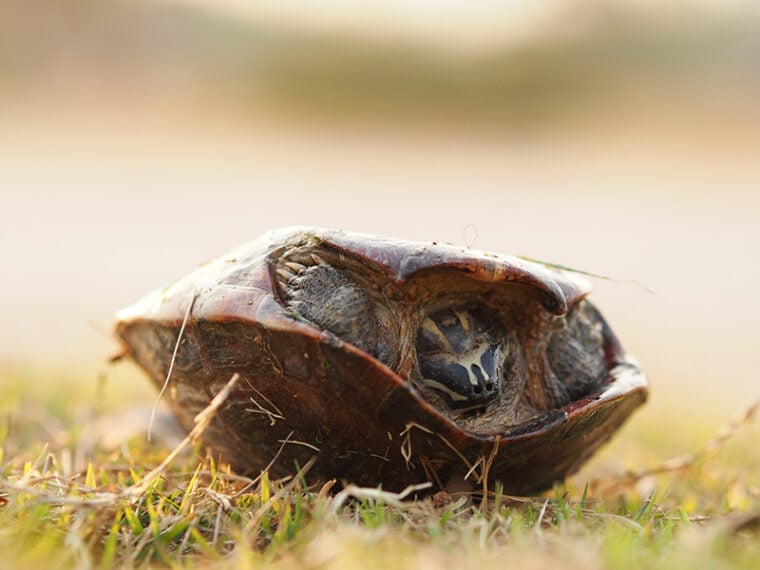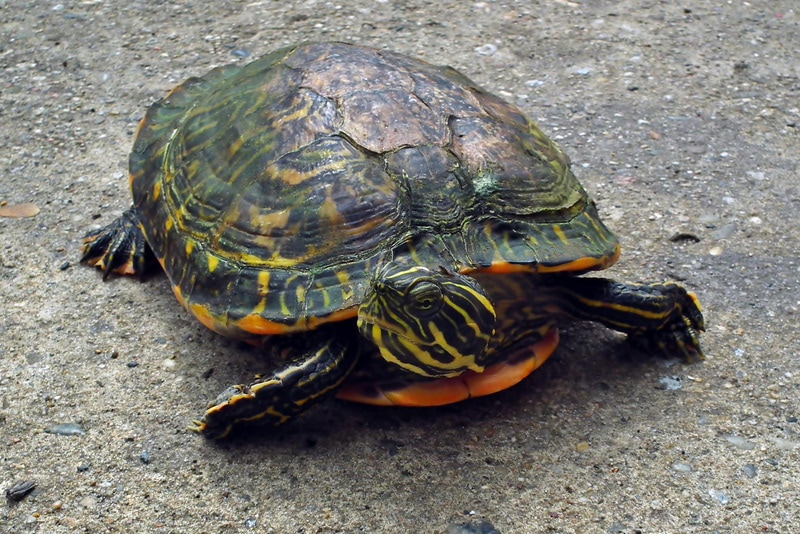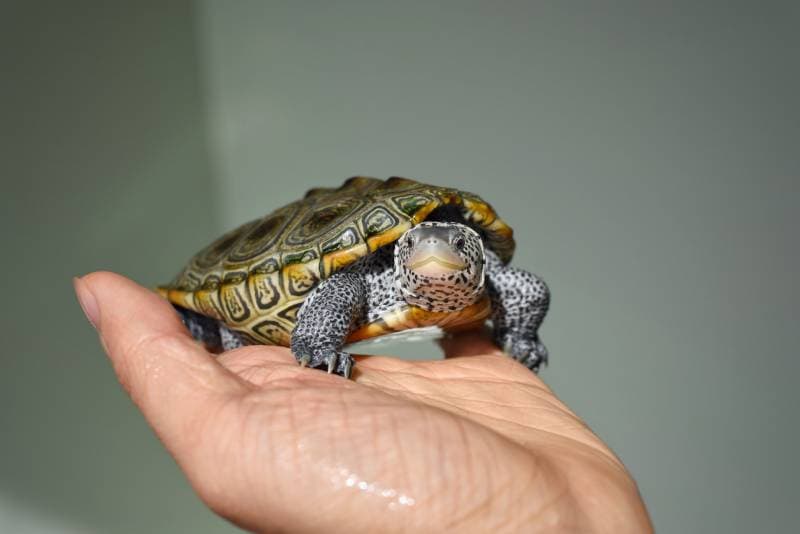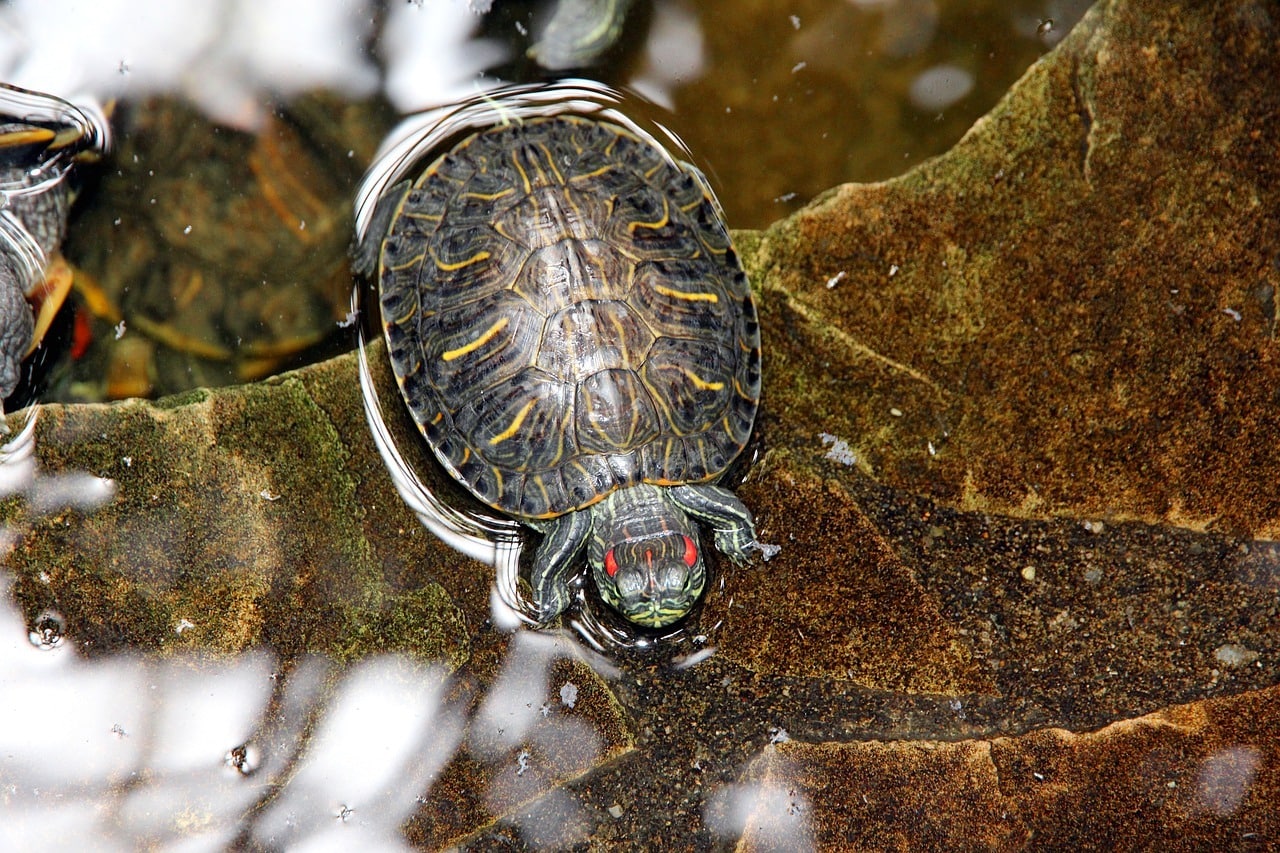
Turtles are resilient reptiles that possess some remarkable adaptations that allow them to navigate even the most challenging situations. From their unique body structure to their resourceful problem-solving skills, turtles have developed ingenious ways to flip themselves back onto their feet. But, one common question that enthusiasts ask is whether or not these adorable creatures can actually flip themselves over, given that they have a thick tough shell on their back. So can turtles actually flip themselves over? Yes, they can. Keep reading as we discuss further.
Can Turtles Flip Themselves Over?
Yes. Turtles are known for their slow and steady pace, but when it comes to flipping themselves over, they can be surprisingly agile. While it may seem like an impossible task for these creatures with their heavy shells and short legs, turtles have developed some unique adaptations that allow them to sort of right themselves when they find themselves on their backs.

Reasons Why Turtles May Flip Over
Turtles can end up flipped over for a variety of reasons. One common cause is a slippery or uneven surface, such as wet grass or rocky terrain, which can make it difficult for them to maintain their balance. Another reason is when turtles are startled or frightened, they may retract their heads and limbs into their shells, causing them to lose their center of gravity and topple over. Also, mating behavior can sometimes result in turtles flipping over, especially during courtship fights which involve pushing and shoving between males.
How Turtles Try to Flip Themselves Back Over
So, how do they do it exactly? Well, when a turtle finds itself flipped over, it initiates a series of actions to try and right itself. The first step is for the turtle to extend its neck as far as possible, using it as leverage to rock its body from side to side. By shifting its weight, the turtle attempts to gain enough momentum to flip itself back onto its feet. If this method fails, turtles may resort to using their legs to push against the ground, using a combination of strength and coordination to roll their bodies over. It’s actually a super slow and laborious process, but turtles are persistent creatures and will continue their attempts until they succeed.
Challenges for Turtles That Are Flipped Over
Being flipped over can pose significant risks to turtles. One immediate and obvious danger is the vulnerability it exposes them to, as their soft underbellies are now exposed to potential predators. Flipped over turtles also face challenges when it comes to their mobility and ability to find food and water. The longer they remain in this position, the greater the risk of dehydration and starvation. In extreme cases, turtles may even suffer from injuries or develop health problems due to the prolonged stress on their bodies.
Should Humans Help Turtles That Are Flipped Over?
Yes, if it doesn’t place you in harm’s way. If you come across a flipped over turtle, there are several ways you can assist them. The first step is to ensure your own safety by approaching the turtle cautiously and avoiding any sudden movements that may startle it further. It’s important to remember that turtles can be easily stressed, so it’s best to keep noise and activity levels to a minimum. To help the turtle flip back over, you can use a flat object like a board or a shovel to gently lift and support its shell. Be careful not to put too much pressure on the shell, as it can cause serious harm to the turtle. Once the turtle is back on its feet, observe from a distance to ensure it moves away safely.

Tips for Preventing Pet Turtles from Flipping Over
While turtles have their own mechanisms for flipping themselves back over, there are steps we can take to reduce the chances of them ending up in this predicament. One effective measure is to provide turtles with a suitable habitat that mimics their natural environment. This includes ensuring the enclosure has ample hiding spots and vegetation, as well as a mix of dry and wet areas for the turtles to explore. Additionally, providing a non-slip surface or adding rocks and logs for traction can help prevent turtles from slipping and flipping over. It’s also crucial to keep an eye out for potential hazards in their surroundings, such as steep slopes or deep-water bodies, and take appropriate measures to minimize the risk.
Other Common FAQs About Turtles
What do turtles eat?
One common question that people ask about turtles is what they eat. Turtles are omnivores, which means they eat both plants and animals – though some eat only plants. Their diet can vary depending on their species and habitat, but in general, turtles eat a variety of foods including insects, leafy greens, worms, fish, fruits, and vegetables.
Do turtles have teeth?
Turtles don’t actually have teeth. Instead, they have sort of a beak-like structure that helps them eat their food. This beak is made up of a hard, keratinous material that allows turtles to bite and chew their prey. While turtles may not have teeth, they’re still able to consume a wide range of food, including plants, insects, and small animals. They use their beak to bite off pieces of food and then swallow it whole or chew it with their strong jaw muscles.
Do turtles bite?
Yes, turtles can bite (with their beak), but it’s important to understand the context in which they may do so. Note that not all turtles are aggressive and prone to biting. In fact, most turtles are known for their peaceful and gentle nature. They’re more likely to retreat into their shells or swim away when they feel threatened, rather than resorting to biting. However, there are instances where turtles may bite.
One common scenario where a turtle may bite is when it feels threatened or cornered. Like any animal, turtles have a natural instinct to defend themselves when they feel in danger. If a turtle feels trapped or scared, it may resort to biting as a means of protecting itself. Although turtle bites can occur, they’re generally not severe. Most turtle species have sharp beaks that allow them to tear through vegetation and prey, but their bites are not powerful enough to cause significant harm to humans – though bigger turtles/tortoises definitely can.

Do turtles make good pets?
While turtles can be fascinating pets, they are not suitable for everyone. Turtles require a significant amount of care and attention, and their long lifespan means that they are a long-term commitment. Additionally, some turtle species can grow quite large and may require a large enclosure or even an outdoor space to live in. Before getting a turtle as a pet, it is important to research the specific needs of the species you are interested in and ensure that you are able to provide the necessary care.
Do turtles blink?
Turtles actually have a rather unique way of protecting their eyes. Unlike humans and many other animals, turtles do not have eyelids. Instead, they have a clear membrane called a nictitating membrane that covers and protects their eyes. This membrane acts as a shield, keeping their eyes moist and preventing debris from entering. While turtles do not blink in the traditional sense, they do have the ability to close their eyes partially or fully when they are feeling threatened or need to rest. This mechanism allows them to maintain their visual health and eye safety.
Why are turtles so slow?
Well, not all turtles are slow. For example, the Eastern Box turtle is actually pretty speedy (check out the videos of it running on YouTube). But, there are a few reasons behind their sluggish nature. First, turtles have a unique body structure that contributes to their slow movement. Their heavy shells and short legs make it difficult for them to move quickly. Additionally, turtles are ectothermic, meaning they rely on external sources of heat to regulate their body temperature. This means that their metabolism is slower compared to warm-blooded animals, resulting in slower movements. Lastly, turtles have evolved to be slow-moving creatures as a survival strategy. Their slow pace helps them conserve energy and avoid predators in their natural habitats.
Do turtles urinate?
Yes, turtles do actually urinate. Turtles have kidneys that filter waste products from their blood–just like humans. These waste products are then excreted from the body in the form of urine. Urine is a liquid waste that is composed primarily of water and dissolved substances such as urea and salts. Turtles have specialized structures called cloacas, which are used for both excretion and reproduction. The cloaca serves as a common opening for the urinary and reproductive systems. So, while turtles may not urinate in the same way that mammals do, they still eliminate waste through the process of urination.
Wrapping Things Up
Contrary to popular belief, turtles are not helpless creatures when it comes to being flipped over. With their unique body structure and resourceful problem-solving skills, they have developed ingenious ways to flip themselves back over themselves when they’re stuck upside down. However, it is important for us as humans to be aware of the dangers and challenges turtles face when they find themselves flipped over. By taking preventive measures and helping them when needed, we can contribute to their safety and ensure they continue to thrive in their natural and captivated habitats.
Featured Image Credit: nineyoii, Shutterstock










